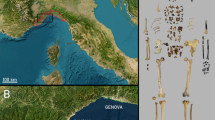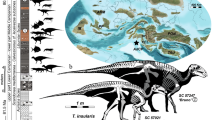Abstract
Homo floresiensis was recovered from Late Pleistocene deposits on the island of Flores in eastern Indonesia, but has the stature, limb proportions and endocranial volume of African Pliocene Australopithecus1. The holotype of the species (LB1), excavated in 2003 from Liang Bua, consisted of a partial skeleton minus the arms. Here we describe additional H. floresiensis remains excavated from the cave in 2004. These include arm bones belonging to the holotype skeleton, a second adult mandible, and postcranial material from other individuals. We can now reconstruct the body proportions of H. floresiensis with some certainty. The finds further demonstrate that LB1 is not just an aberrant or pathological individual, but is representative of a long-term population that was present during the interval 95–74 to 12 thousand years ago. The excavation also yielded more evidence for the depositional history of the cave and for the behavioural capabilities of H. floresiensis, including the butchery of Stegodon and use of fire.
This is a preview of subscription content, access via your institution
Access options
Subscribe to this journal
Receive 51 print issues and online access
$199.00 per year
only $3.90 per issue
Buy this article
- Purchase on Springer Link
- Instant access to full article PDF
Prices may be subject to local taxes which are calculated during checkout







Similar content being viewed by others
References
Brown, P. et al. A new small-bodied hominin from the Late Pleistocene of Flores, Indonesia. Nature 431, 1055–1061 (2004)
Morwood, M. J. et al. Archaeology and age of a new hominin from Flores in eastern Indonesia. Nature 431, 1087–1091 (2004)
Weidenreich, F. The mandible of Sinanthropus pekinensis. A comparative study. Palaeontologica Sinica D7, 1–132 (1936)
Kaifu, Y. et al. Taxonomic affinities and evolutionary history of the early Pleistocene hominids of Java: Dentognathic evidence. Am. J. Phys. Anthropol. published online 10 March 2005 (doi:10.1002/ajpa.10425)
Vekua, A. K. et al. A new skull of early Homo from Dmanisi, Georgia. Science 297, 85–89 (2002)
Wood, B. A. & Uytterschaut, H. Analysis of the dental morphology of the Plio-Pleistocene hominids. III. Mandibular premolar crowns. J. Anat. 154, 121–156 (1987)
Wood, B. A., Abbott, S. A. & Uytterschaut, H. Analysis of the dental morphology of Plio-Pleistocene hominids. IV. Mandibular postcanine root morphology. J. Anat. 156, 107–139 (1988)
Gabounia, L., de Lumley, M.-A., Vekua, A., Lordkipanidze, D. & de Lumley, H. Découverte d'un nouvel hominidé à Dmanissi (Transcaucasie, Géorgie). C.R. Palevol 1, 243–253 (2002)
Wolpoff, M. H. in Size and Scaling in Primate Biology (ed. Jungers, W. L.) 273–318 (Plenum, New York, 1985)
Schwartz, J. & Tattersall, I. The human chin revisited: what is it and who has it? J. Hum. Evol. 38, 367–409 (2000)
Lavelle, C. L. Investigation of mandibular and neurocranial form. Acta Anat. 125, 238–244 (1986)
Lavelle, C. L. A preliminary craniofacial profile evaluation of normo-, micro- and macro-cephalics. Br. J. Orthod. 13, 13–21 (1986)
White, T. D. & Johanson, D. C. Pliocene hominid mandibles from the Hadar formation, Ethiopia: 1974–1977 collections. Am. J. Phys. Anthropol. 57, 501–544 (1982)
Walker, A. C. & Leakey, R. (eds) The Nariokotome Homo erectus Skeleton (Harvard Univ. Press, Cambridge, 1993)
Haeusler, M. & McHenry, H. M. Body proportions of Homo habilis reviewed. J. Hum. Evol. 46, 433–465 (2004)
Oliver, G. The stature of Australopithecus. J. Hum. Evol. 5, 529–534 (1976)
Hens, S. M., Konigsberg, L. W. & Jungers, W. L. Estimating stature in fossil hominids: which regression model and reference sample to use. J. Hum. Evol. 38, 767–784 (2000)
Evans, F. G. & Krahl, V. E. The torsion of the humerus: a phylogenetic study from fish to man. Am. J. Anat. 76, 303–337 (1945)
Larson, S. G. Subscapularis function in gibbons and chimpanzees: implications for interpretation of humeral head torsion in hominoids. Am. J. Phys. Anthropol. 76, 449–462 (1988)
Johanson, D. C. et al. Morphology of the Pliocene partial hominid skeleton (A.L. 288–1) from the Hadar Formation, Ethiopia. Am. J. Phys. Anthropol. 57, 403–451 (1982)
Roberts, D. F. in Addison-Wesley Module in Anthropology 1–38 (Addison-Wesley, Reading, 1973)
Ruff, C. B. Morphological adaptation to climate in modern and fossil hominids. Yb. Phys. Anthropol. 37, 65–107 (1994)
Aiello, A. & Dean, C. An Introduction to Human Evolutionary Anatomy (Academic, London, 1990)
Schmid, P. Eine rekonstrucktion des skelettes von A.L. 288–1 (Hadar) und deren konsequenzen. Folia Primatol. (Basel) 40, 283–306 (1983)
Hiralal, G. M., Silverman, B. L., Dupuis, J. & Baumann, G. Phenotype and genetic analysis of a syndrome caused by an inactivating mutation in the growth hormone-releasing hormone receptor: Dwarfism of Sindh. J. Clin. Endocrinol. Metab. 83, 4065–4074 (1998)
Falk, D. et al. The brain of LB1, Homo floresiensis. Science 308, 242–245 (2005)
Martin, R. D. Relative brain size and basal metabolic rate in terrestrial vertebrates. Nature 293, 57–60 (1981)
Köhler, M. & Moyà-Solà, S. Reduction of brain and sense organs in the fossil insular bovid Myotragus. Brain Behav. Evol. 63, 125–140 (2004)
van der Geer, A. A. E. On the astragalus of the Miocene endemic deer Hoplitomeryx from the Gargano (Italy). Deinsea 7, 325–336 (1999)
Acknowledgements
The 2004 excavations at Liang Bua were funded by a Discovery Project grant from the Australian Research Council (ARC) to M.J.M. The ARC also supported R.G.R. through a Senior Research Fellowship. K.E.W. was in receipt of postgraduate scholarships from the University of Wollongong, and P.B. and T.M. received a grant from the University of New England. Excavations were undertaken under Asisten Deputi Urusan Arkeologi Nasional, Number 1100/SB/U.ARNAS/VII/04, and Pemerintah Kabupaten Manggarai, Surat Rekomendasi No: 565/Kesbang.IV/VII/2004β. R. P. Soejono was the Indonesian Institutional Counterpart. Other participants included C. Lentfer, G. van den Bergh, C. Turney, D. Hobbs, K. Grant, D. Y. Yuniawati, A. Brumm, Rikus, Deus, Leo, Ansel, Agus, Seus, Camellus, Gaba, Rius, Beni and Piet. P. Jordan, D. Falk, S. G. Larson and K. Morwood commented on an earlier version of the paper, and D. Hobbs redrafted Fig. 1. P.B. and T.M. thank R. Kruszynski (Natural History Museum, London), R. Orban (Institut Royal des Sciences Naturelles de Belgique, Bruxelles) and W. Wendelen (Royal Museum of Central Africa, Tervuren) for providing access to skeletal collections in their care. Author Contributions M.J.M. was Chief Investigator and the Australian Institutional Counterpart in this ARC project. P.B. was responsible for analysis and interpretation of the hominin remains. T.S., J., E.W.S., R.A.D. and S.W. directed aspects of the excavations, recording and analyses. Thermoluminescence ages were provided by R.G.R. and K.E.W., who also described the stratigraphy. T.M. and P.B. collected comparative data on small-bodied modern humans and non-human primates. As Director of the Indonesian Centre for Archaeology, T.D. authorized the excavations, provided support and assisted with stratigraphic interpretation.
Author information
Authors and Affiliations
Corresponding authors
Ethics declarations
Competing interests
Reprints and permissions information is available at npg.nature.com/reprintsandpermissions. The authors declare no competing financial interests.
Supplementary information
Supplementary Methods
This file contains Supplementary Methods and Supplementary Table S1. (PDF 25 kb)
Supplementary Notes
This file contains Supplementary Tables S2 and S3, Supplementary Figures S1–S6 and additional references. (PDF 466 kb)
Supplementary Figure S6
Plan of Liang Bua showing the distribution of excavated sectors. (PDF 4021 kb)
Rights and permissions
About this article
Cite this article
Morwood, M., Brown, P., Jatmiko et al. Further evidence for small-bodied hominins from the Late Pleistocene of Flores, Indonesia. Nature 437, 1012–1017 (2005). https://doi.org/10.1038/nature04022
Received:
Accepted:
Published:
Issue Date:
DOI: https://doi.org/10.1038/nature04022
This article is cited by
-
Early presence of Homo sapiens in Southeast Asia by 86–68 kyr at Tam Pà Ling, Northern Laos
Nature Communications (2023)
-
Characterising the stone artefact raw materials at Liang Bua, Indonesia
Journal of Paleolithic Archaeology (2022)
-
A Middle Pleistocene Denisovan molar from the Annamite Chain of northern Laos
Nature Communications (2022)
-
Isotopic evidence for initial coastal colonization and subsequent diversification in the human occupation of Wallacea
Nature Communications (2020)
-
A genotype:phenotype approach to testing taxonomic hypotheses in hominids
The Science of Nature (2020)
Comments
By submitting a comment you agree to abide by our Terms and Community Guidelines. If you find something abusive or that does not comply with our terms or guidelines please flag it as inappropriate.



